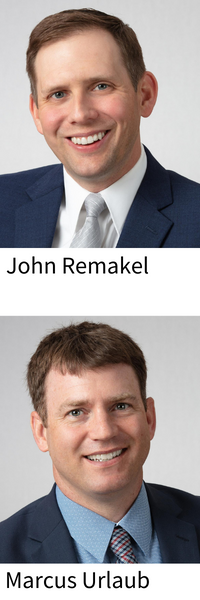 John Remakel is a shareholder at the law firm Monroe Moxness Berg and advises private companies and family-owned businesses and owners, serving as counsel on transactional, corporate finance and business law matters. He leads the firm’s securities law practice and focuses on representing emerging companies and concepts, with clients across a variety of industries and sectors. John is a member of St. Bartholomew Catholic Church in Wayzata.
John Remakel is a shareholder at the law firm Monroe Moxness Berg and advises private companies and family-owned businesses and owners, serving as counsel on transactional, corporate finance and business law matters. He leads the firm’s securities law practice and focuses on representing emerging companies and concepts, with clients across a variety of industries and sectors. John is a member of St. Bartholomew Catholic Church in Wayzata.
Marcus Urlaub is a shareholder at the law firm Monroe Moxness Berg and practices in the areas of estate planning, wealth preservation, estate and trust administration, and more. He also assists the firm in a variety of matters, including mergers and acquisitions, business and corporate structuring, and shareholder and employment agreements. Marcus is a member of Nativity of Mary Catholic Church in Bloomington.
The Catholic Community Foundation of Minnesota (CCF) believes philanthropy enriches lives. Considering how charitable giving might fit into our business plans only grows our capacity to positively impact our community. We asked John and Marcus to help us understand how philanthropy might fit into a business sale.
What Is a Donor Advised Fund (DAF)?
A DAF is a fund held at a public charity or foundation for the purpose of managing charitable donations. It operates like a charitable checking account. The donor deposits assets (e.g., cash, securities, private company stock) and then recommends grants over time to nonprofit organizations and charities that the DAF steward vets and pre-qualifies.
Potential Advantages
- Immediate tax deduction in the year of gift to fund, equal to the fair market value of the donation (subject to AGI limitations).
- Assets grow tax free while held in the DAF.
- Accounts are managed by the fund steward, reducing the cost and time associated with private foundations.
- Assets sold when held in the DAF do not recognize capital gains.
An Example of the Impact of a DAF in M&A
Bruce owns a private company and is considering a sale. The business has a current valuation of approximately $10 million.
Prior to going to market, Bruce donates 25% of the company’s stock to a DAF. Bruce receives an immediate charitable deduction based on the value of the company at the time.
One year later, Bruce enters into a transaction to sell the company for $10 million. At closing, Bruce receives $7.5 million, and his DAF receives $2.5 million. Bruce pays tax on his sale proceeds (after accounting for his basis in the stock, possible recapture tax, etc.). The $2.5 million in proceeds to the DAF are tax free.
For illustrative purposes, let’s assume a combined tax rate of 25% on Bruce’s sale. Without his donation to the DAF, Bruce would have $7.5 million after tax but no assets set aside for charity.
However, with the DAF planning, Bruce has $5.6 million after tax ($7.5 million less 25% tax), and his DAF has $2.5 million for a net total of $8.1 million between Bruce and his DAF. Plus, Bruce already received the tax benefit of the original donation to the DAF described above.
Planning Is Necessary
Tax and legal matters relating to DAFs are highly complex with timing considerations, valuation concerns, AGI limitations, etc. We recommend that a potential donor speak with a tax advisor and/or attorney.
4881-2492-8048, v. 1
As John and Marcus outline above, incorporating philanthropy into business succession planning can greatly grow a donor’s capacity to give. And when donors partner with CCF, they can rest assure that their blessings are invested in alignment with their Catholic faith.
The information presented above by the Catholic Community Foundation of Minnesota (CCF) is general and educational in nature. CCF and its staff do not provide individualized legal or tax advice. We recommend you consult with your attorney or tax professional regarding your unique personal situation.

